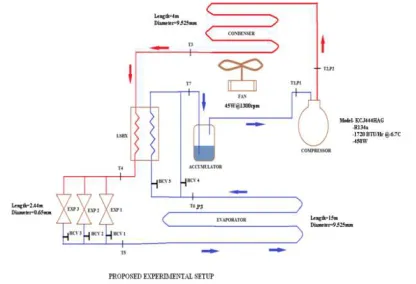Available Online At www.ijpret.com
INTERNATIONAL JOURNAL OF PURE AND
APPLIED RESEARCH IN ENGINEERING AND
TECHNOLOGY
A PATH FOR HORIZING YOUR INNOVATIVE WORK
PERFORMANCE EVALUATION OF WATER CHILLER USING LSHX UNDER
VARYING LOAD AND SUCTION TEMPERATURE
RANJEET KEKAN1, DR. SHETE J.P.2
1. PG Students of Vishwakarma Institute of Technology, Pune. 2. Faculty in Vishwakarma Institute of Technology, Pune.
Accepted Date:
27/02/2013 Publish Date:
01/04/2013
Keywords
Liquid Suction Heat
Exchanger,
Compressor Selection,
Condenser Selection,
LSHX Design,
WaterChiller.
Corresponding Author Mr. Ranjeet Kekan
Abstract
This paper considers the influence of heat exchangers to the
efficiency of water chillier. A tube and tube type heat exchanger is
used to compare the coefficients of performance of the vapor
compression system with and without liquid suction heat
exchanger. To change the operating suction temperature
(evaporator temperature) the application of three different capillary
tubes is to be done. The approximate temperature range will be
+50C to -50C, in three steps. And performance of liquid suction heat
exchanger (LSHX) will be evaluated for present water chiller. Again
the evaporator will be loaded at different masse of water and with
this change in load on evaporator the performance of LSHX is
studied. With these varying conditions the performance of LSHX is
to be evaluated with use of change in coefficient of performance,
operating condenser and evaporator pressure and temperatures.
The expected results are raise in COP with 6 to 9%, increase in
Available Online At www.ijpret.com I. INTRODUCTION
‘‘Heat exchanger’’ is a common device, in
which heat interchange between a
refrigerant in a suction line and a liquid
refrigerant in a capillary tube occurs. It is
used in most household systems in order to
ensure the necessary superheat at the
compressor’s inlet section, while promoting
certain sub cooling before the capillary
tube.
The performance of Rl34a water chiller
systems has been continuously improved
over the last years. However, the potential
benefits associated with the
implementation of a liquid suction heat
exchanger (LSHX) - also termed internal
heat exchanger - have not been paid much
attention according to the published
literature. A LSHX transfers energy from
the refrigerant leaving the condenser to the
suction gas, resulting in a lower inlet
enthalpy at the evaporator, providing a
higher cooling capacity. The competing
effects with respect to performance are a
larger enthalpy change across the
compressor and a lower mass flow rate,
both effects caused by the lower suction
density. An Rl34a prototype system was
operated with and without a LSHX, the
performance comparison is presented in
this paper.
The most common in household
refrigerators is the tube-in-tube heat
exchanger with a capillary tube placed
concentrically inside the suction tube.
Another widespread design is the heat
exchanger with a capillary tube welded to
the outer surface of the suction tube. Heat
exchangers of both types have
shortcomings a heat exchanger with
concentric tubing has at least two
additional tube junctions and is less
efficient. A heat exchanger with a capillary
welded to the outer surface of the suction
tube is higher in price. Such heat
exchangers prevail in freezers. Usually they
are made by specialized manufacturers as
one piece together with evaporator.
This paper presents a relatively new heat
exchanger, which is similar to the tube and
tube type one from a thermodynamic point
of view, but has advantages in some cases.
The copper fins are mounted on inner tube
Available Online At www.ijpret.com
maintain equal-space between two tubes
along length of heat exchanger.
II. LITERATURE REVIEW
S.A. Klein, D.T. Reindl, K. Brownell have
studied Refrigeration system performance
using liquid-suction heat exchangers in
2000 and found that liquid-suction heat
exchangers increase the temperature and
reduce the pressure of the refrigerant
entering the compressor causing a decrease
in the refrigerant density and compressor
volumetric efficiency.[1]
Consequently, the refrigerant flow rate
decreases with increasing effectiveness of
the liquid-suction heat exchanger. The
presence of a liquid-suction heat exchanger
produces opposing effects on refrigeration
capacity. The refrigerating effect per unit
mass flow rate increases due to an
increasing enthalpy difference across the
evaporator (as seen in Figure 1; however,
the mass flow rate itself decreases due to
the effects of decreasing suction density
resulting from increased temperature and
reduced pressure at state 2 when pressure
losses in the heat exchanger are
considered. The net effect of the
liquid-suction heat exchanger on the relative
capacity index for eleven refrigerants at a
saturated evaporator temperature of -200C
and a saturated condensing temperature of
400C is shown in Figure 1.
From detailed analyses, it can be
concluded that liquid-suction heat
exchangers that have a minimal pressure
loss on the low pressure side are useful for
systems using R507A, R134a, R12, R404A,
R290, R407C, R600, and R410A. The
liquid-suction heat exchanger is detrimental to
system performance in systems using R22,
R32, and R717 [1].
Figure 1: Effectiveness of LSHX vs. Relative
capacity index for different refrigerants.[1]
M. Preissner, B. Cutler, R. Radermacher, C.
A. Zhang have studied Suction Line Heat
Available Online At www.ijpret.com
Conditioning System in 2000 and found that
the COP and the capacity increased on the
order of 5 to 10 % with a suction line heat
exchanger with 60 % effectiveness.[2]
They also found that the performance
decrease associated with an additional
pressure drop at the low pressure side,
calculations were carried out with a
program based on fitted cycle parameters
from the experimental data set, the penalty
of the pressure drop on the low pressure
side of the suction line heat exchanger is
shown in Figure 2. A 5 bar pressure drop
reduces capacity and COP by about 10%. [2]
Figure 2: Performance penalty of pressure
drop at the suction side. [2]
V.Dagilis, L.Vaitkus, A.Balcius has studied
Liquid–gas heat exchanger for household
refrigerator in 2004. They performed
experiment with three type of LSHX, mostly
common in household refrigerators are the
tube-in-tube heat exchanger with a capillary
tube placed concentrically inside the
suction tube. Another widespread design is
the heat exchanger with a capillary tube
welded to the outer surface of the suction
tube. [3]
And found that the heat exchanger with
concentric tubing is much more sensitive to
lower than optimal inner diameter of the
suction tube. For a refrigerating system
with this heat exchanger, the inner
diameter, lower than the optimal by 30%,
will cause a decrease of COP by 7%, which is
unacceptable. All types of heat exchangers
are less sensitive to higher than optimal
inner diameter. Therefore, if a tube with an
optimal diameter is not available, it is
preferable to use a tube with a higher
diameter.[3]
R. Mastrullo, A.W. Mauro, S. Tino , G.P.
Vanoli has studied possible advantage of
adopting a suction/liquid heat exchanger in
refrigerating system in 2007 and found that
Available Online At www.ijpret.com
performance depending on the operating
conditions.[4]
In Figure 3A and 3B, the COP’/ COP ratio
for different two refrigerants (717 and
R-134a) is presented. It’s possible to see that
the addition of the LSHX is not convenient
for the R-717, for the all considered
operating conditions; on the other side for
the R-134a it is always advantageous [4].
Erik Bjork, Bjorn Palm has studied
Performance of a domestic refrigerator
under influence of varied expansion device
capacity, refrigerant charge and ambient
temperature in 2006. The method outlined
in the introduction on how to determine
the capillary tube length and quantity of
charge can be recommended as it takes
different thermal loads and thermal masses
(food in cabinet) into consideration.
They also studied the influence of LSHX and
found that Suction line heat exchangers
(LSHX) are typically used in domestic
refrigeration.
They increase the total efficiency and
prevent external condensation on the
suction line between the LSHX and the
compressor. The overall influence from
LSHX is that it increases the capillary tube
capacity, lowers the evaporator inlet quality
and increases the suction line temperature
(at compressor inlet).
Figure 3A: The COP’/COP ratio for R-717, for
various condensing temperature and
evaporating temperature [4]
As a result the optimum capillary tube
length needs to be longer and the charge
possibly a little higher (the LSHX allows the
dry-out point closer to the evaporator
Available Online At www.ijpret.com
Figure 3B: The COP’/COP ratio for R-134a,
for various condensing temperature and
evaporating temperature [4]
R. A. Peixoto and C. W. Bullard has studied
that application of capillary tube in the
liquid suction heat exchanger will give
better results with R134a rather than R22,
due to its lower specific volume. They also
found that the capillary tube LSHX have
lower results than the lateral LSHX, due to
decreases of flow area in suction tube. They
also found that the length of LSHX with
capillary tube is much long than lateral
LSHX. The compressor volumetric efficiency
is higher for R134a than R22 as the density
of R134a is more than R22, also the mass
flow rate required for R134a is less than
R22 because of its higher latent heat than
R22 at same saturation evaporator
temperature [6]
Figure 4A: lateral capillary tube LSHX [6]
Figure 4B: concentric capillary tube LSHX [6]
III. SYSTEM DESCRIPTION
3.1 Compressor selection:
Cooling capacity calculations:
Let suppose, we want to cool 10 kg of
water in ½ hr from 300C to 50C,
Therefore cooling load will be,
Qe=m*Cp*ΔT/1800………… (kW)
=10*4.2*25/1800…..… (kW)
=1050/1800……..….… (kW)
=0.5833……..…….….. (kW)
Available Online At www.ijpret.com
But, 1 kW cooling= 3418.80 BTU/hr cooling.
Therefore, 0.6kW cooling=2051 BTU/hr.
Therefore, selection of compressor from
catalogue of “Emerson compressors”.
Model-KCE444HAG
Refrigerant R134a.
Cooling capacity 1720 BTU/hr
Input power 450W
3.2 Condenser selection
Heat rejection through condenser is
addition of heat supplied through
evaporator and work done in compressor.
Qc= Qe + Wc
=0.6 + 0.45 kW
=1.05 kW
Therefore, selecting a condenser of 1.5 kW
which is suitable for system.
Thermal model
The model is based on the mass,
momentum and Energy conservation
equations applied to both the refrigerant
and air streams. The model predictions
were compared with experimental data
taken at several operating and geometric
conditions.
The thermal sub-model was divided into
two domains namely, air and refrigerant
streams. The thermal resistances due to
heat conduction through the tube and fin
walls were neglected due to the relatively
high thermal conductivity of the walls in
comparison to the external convection heat
transfer.
Figure 5: Schematic representation of the
Available Online At www.ijpret.com
Figure 6: Tube-fin type condenser [7]
Therefore, the air and refrigerant streams
were modeled based on the following
energy balances applied to the control
volume illustrated in Figure 5.
where mr and ma,cv are the refrigerant and
the air mass flow rates through the control
volume [kg/s], respectively, h is the
refrigerant specific enthalpy [J/kg], and the
indices i and o refer to the inlet and outlet
ports of the control volume, respectively.
The heat transfer rate Qcv was calculated
from the concept of heat exchanger
effectiveness, as follows:
Figure 7: Schematic representation of the
fan-coil hydrodynamic interaction [7]
where “+” should read “_” when the
refrigerant transfers heat to the air stream
(condensers and gas coolers) and “+” when
the refrigerant receives heat from the air
stream (evaporators). Cmin = min (mrcp,r OR
ma, cp,a) is the lowest thermal capacity
[W/K] of the streams, and ti,h and ti,c are the
temperatures of the hot and cold streams
at the entrance ports, respectively. The
control volume effectiveness (ε) for a
mixed, cross-flow, single-pass heat
exchanger with single phase refrigerant was
Available Online At www.ijpret.com
Where Cr = Cmin/Cmax, and NTU = UA/Cmin is
the number of transfer units. In the
two-phase flow regions, the control volume
effectiveness was calculated as follows:
The thermal conductance UA was obtained
from
where ŋf is the fin efficiency calculated from
the procedure introduced by Schmidt. Eqs.
(1) to (5) were solved following the
refrigerant coil arrangement (see Figure 5)
assuming that each control volume behaves
as an individual heat exchanger. [7]
Thus, although the air and refrigerant
streams were modeled as one-dimensional,
the three dimensional nature of the coil
circuit was retained by the model. The heat
transfer coefficients required by the model
were obtained from empirical correlations.
The air-side heat transfer coefficients were
selected based on a study performed using
a wind-tunnel facility, whereas the single
and two-phase refrigerant side heat
transfer coefficients were obtained from
Gnielinski and Bassi and Bansal
correlations, respectively. The air and
refrigerant thermodynamic and thermo
physical properties were calculated through
the REFPROP7 software linked to the EES
platform. [7]
Experimental apparatus
Experiments were carried out with a series
of tube-fin heat exchanger samples
particularly designed for light commercial
refrigeration applications. The tests were
performed using a closed-loop wind-tunnel
calorimeter facility specially constructed for
testing tube-fin heat exchangers according
to the ANSI/ASHRAE 33 standard. The
wind-tunnel comprised of a variable-speed radial
fan to control the air flow rate. Compact
fan-supplied tube-fin heat exchangers for
light commercial refrigeration applications,
i.e., with heat duties ranging from 0.5 to 2.0
kW are listed in table 1.
Table 1: Geometric characteristics of the
Available Online At www.ijpret.com
Sample 1 2 3 4
Ff (mm) 2.53 3.88 2.86 3.04
Str (mm) 25.6 25.5 25.5 25.6
Slo (mm) 21.67 20.33 20.33 22.5
dt (mm) 9.5 9.5 9.5 9.5
δf (mm) 0.14 0.14 0.14 0.14
L (mm) 304 304 304 304
H (mm) 256 153 153 256
W(mm) 65 61 61 45
The experimental apparatus was designed
for air flow rates ranging from 170 and 2000
m3/h, refrigerant mass flow rates up to 250
kg/h, and refrigerant pressures up to 20
bars.
Specifications of selected condenser-
Copper tube length (l) =8 m,
Copper tube diameter (dt) =9.5 mm.
Fin pitch (Ff) =2.48 mm.
Material of fin is aluminum.
Condenser height (H) = 250 mm
Condenser length (L) = 270 mm and
Condenser width (W) = 50mm.
3.3 Design of heat exchanger:
We have a set of reading from ordinary
water chiller, which is having same
specifications as our selected compressor
(Table 2).
A practical model of the heat exchanger
was formed by taking into consideration the
following assumptions:
1. Refrigerant vapor in the suction tube is
superheated.
2. Heat exchange with environment is
neglected.
3. Heat flow is considered as steady state.
4. A refrigerant in the capillary tube is in
liquid state.
Now, from readings of table no. 2 it is
clear that we can reduce the condenser
outlet temperature around 350C and the
Available Online At www.ijpret.com
evaporator. Therefore allowable
temperature drop is around 250C.
Table 2: Readings set for ordinary water
chiller.
Therefore, heat exchanged
heat exchanged Q= m*Cpl*ΔT kW
Heat exchanged Q= 0.1 kW
Now, heat transferred in LSHX is,
Q= h*A*ΔTLM
100=450*A*17
A=0.013 m2
As our LSHX is a tube and fin type of heat
exchanger.
Therefore, total heat exchanging area equal
to area of tube and area of fin. The fin is a
helical wound of a copper strip having 4mm
height.
Therefore, total heat exchanging
area is
A= 2*Π*r*l + [2*n*((2Πr) 2+ (l/n) 2)) 1/2*h]
(in m2)
Where, radius of inner pipe r = 0.00325 m
Number of turns of copper fin ‘n’
Length of heat exchanger l in meter
Time 10:37 11:09 11:29
Suction
Pressure P1 (bar)
2.6 2.2 2
Discharge
pressure P2 (bar)
15.6 14.2 13.3
Suction
temperature T1 ( 0C)
17.1 12 2.8
Discharge
temperature T2 (0C)
55.3 68.5 69.3
Condenser
outlet temp. T3 (0C)
46.3 45.7 43.1
Capillary
outlet temp. T3 (0C)
9.5 4.9 1.5
Water
temperature T5 (0C)
25.2 12 10
Supply
Voltage V (Volts)
215 214 213
Supply current
I (Amp)
Available Online At www.ijpret.com
Height of fin, h = 4mm
We have performed iterations to get
optimized number turns of fin and length of
heat exchanger.
Therefore, selecting a heat exchanger which
is having 10 turns of fin over 44 cm tube
length from table no. 3.
Table 3: Relation between ‘n’ and ‘l’.
Number of turns
‘n’
Length ‘l’
(m)
n/l
10 0.44 23
15 0.42 36
20 0.40 50
30 0.35 86
40 0.29 138
3.3 Proposed experimental setup:
The LSHX was tested in the Rl34a water
chiller test facility. The evaporator is placed
in a water tank of variable capacity.
The temperature of water is recorded
with use of thermocouple. With the use of
quantity of water used and the temperature
drop reading, refrigerating effect can be
calculated.
Condenser is exposed to open
atmosphere and it is forced cooled. Two
thermocouples and to pressure gauge are
placed across the condenser, to get the
reading of temperature and pressure drop
across the condenser.
The schematic setup of the R134a loop is
shown in Figure 8. The compressor is placed
in the same climate chamber as the
condenser, and consequently, is exposed to
the condenser air inlet temperature. A
digital voltmeter and ammeter are joined to
compressor electrical supply lines, to get
Available Online At www.ijpret.com
Figure 8: Proposed experimental setup
The refrigerant leaving the compressor
passes the condenser and can then be
routed through the liquid suction heat
exchanger. The suction line heat exchanger
transfers heat to the suction gas, providing
more cooling capacity and improving the
cycle COP.
We have three capillaries placed, with
different capacities. After passing the
expansion device (manually controlled), the
refrigerant evaporates in the evaporator
and passes through the LSHX and enters the
accumulator. Liquid refrigerant and oil are
stored in this device a small amount of the
oil-refrigerant mixture passes through a
bleed hole at the bottom inside of the
accumulator to the main refrigerant line to
ensure proper compressor lubrication. The
refrigerant loop is equipped with in-stream
thermocouples and pressure gauges at the
inlet and outlet of the main components.
IV. SYSTEM ANLYSIS
4.1 Analysis of COP:
From above observation table we can
determine the COP of system for a
particular load and suction temperature
with and without LSHX.
Let’s assume,
COP= coefficient of performance without
LSHX
COP’= coefficient of performance with LSHX
Therefore we can have graphs of
A] COP’ vs. suction temperature at different
loads. (With LSHX)
B] COP vs. suction temperature at different
loads. (Without LSHX)
C] COP’ vs. load on evaporator at different
suction temperature. (With LSHX)
D] COP vs. load on evaporator at different
suction temperature. (Without LSHX)
With this other properties like compressor
power, refrigerating capacity, pressure drop
across LSHX can be studied.
V. CONCLUSION
From the available references, it is seen
Available Online At www.ijpret.com
the COP of the system with the use of the
LSHX system.
The effectiveness of LSHX system can be
improved by proper selection and design of
the LSHX.
The effect of the LSHX system on the
performance of the water chiller system can
be studied by variation in the operating
conditions of the system.
VI. REFERENCES
1. S.A. Klein , D.T. Reindl, K. Brownell
,“Refrigeration system performance using
liquid-suction heat exchangers”.
International Journal of Refrigeration 23
(2000) 588 - 596, (2000).
2. M.Preissner, B. Cutler, R. Radermacher,
C. A. Zhang ,“Suction Line Heat exchanger
for R134a Automotive Air-Conditioning
System”. International Refrigeration and Air
Conditioning Conference. Paper 494.
(2000).
3. V.Dagilis, L.Vaitkus, A.Balcius , “Liquid–
gas heat exchanger for household
refrigerator” International Journal of
Refrigeration 27 (2004) 235–241, 2004.
4. R. Mastrullo, A.W. Mauro, S. Tino , G.P.
Vanoli, “A chart for predicting the possible
advantage of adopting a suction/liquid heat
exchanger in refrigerating system” Applied
Thermal Engineering 27 (2007) 2443–2448,
2007.
5. Erik Bjork, Bjorn Palm, “Performance of
a domestic refrigerator under influence of
varied expansion device capacity,
refrigerant charge and ambient
temperature”. International Journal of
Refrigeration 29 (2006) 789–798, 2006.
6. R.A.Peixoto and C.W.Bullard,” A
Design Model for Capillary Tube-Suction
Line Heat Exchangers” ACRCTR-53, 1994.
7. Maicon Waltrich , Christian J.L.
Hermes , Joaquim M. Goncalves , Claudio
Melo,” A first-principles simulation model
for the thermo-hydraulic performance of
fan supplied tube-fin heat exchangers”.
Applied Thermal Engineering 30, 2010.
8. Refrigeration and air conditioning by
C.P.Arora, third edition. Pp 286-302, 2009.
9. R.J.Dosat, “fundamentals of
refrigeration”, second edition. Pp 717-723,
Available Online At www.ijpret.com
10.Khurmi and Gupta,”Refrigeration and air
conditioning”, fourth edition. Pp 152-156,
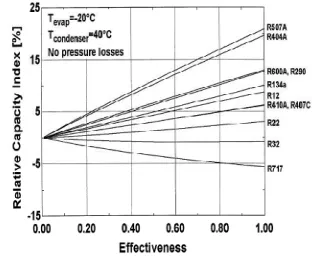
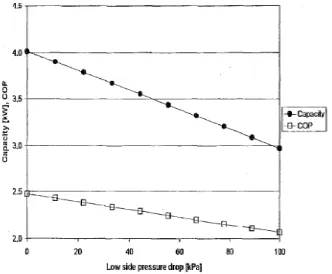

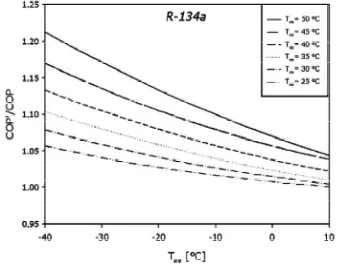
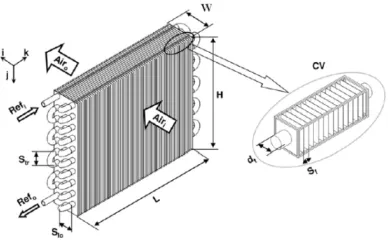
![Figure 6: Tube-fin type condenser [7]](https://thumb-us.123doks.com/thumbv2/123dok_us/8757032.1750179/8.595.325.502.122.248/figure-tube-fin-type-condenser.webp)
